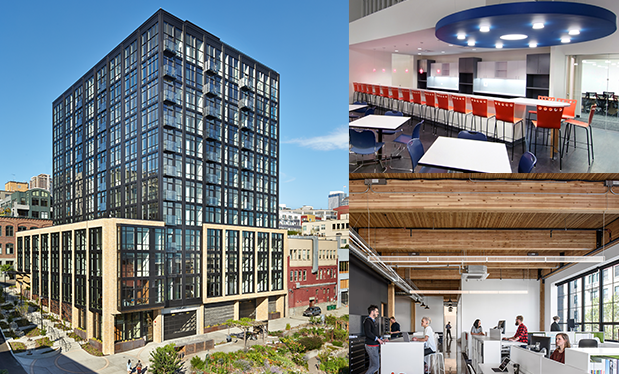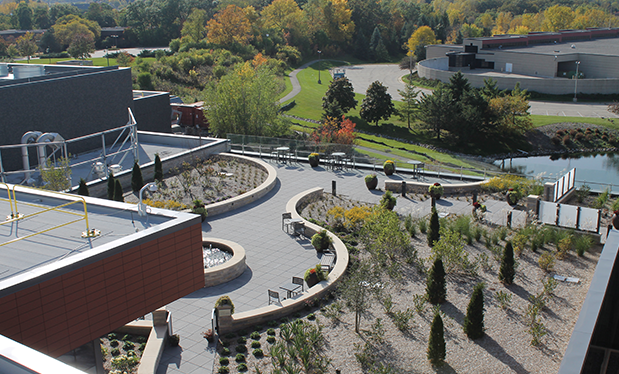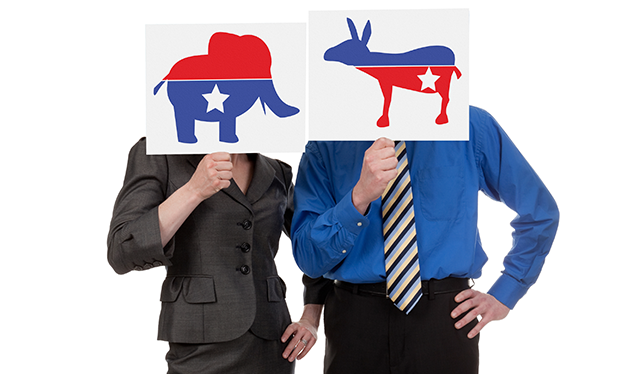With a move toward sustainability in the commercial building and construction sectors, sustainable design is at the forefront of everyone's minds. And the reason is no secret: Sustainably designed projects have a generally lower effect on the environment and offer favorable operating costs long-term. An easy way to incorporate sustainability into a commercial building envelope is to leverage the benefits of a vegetative roof system into the building's design.
The use of vegetative roof systems is not new. During the 1960s, more refined engineered vegetative roof systems were being used on buildings to aid with managing stormwater. Currently, there are about 30 to 35 North American municipalities that provide policies, incentives or regulations related to vegetative roofs. Chicago; Philadelphia; Seattle; Washington, D.C.; and many other large cities have programs in place for the use of vegetative roof systems.
Aside from incentive programs, vegetative roof systems offer numerous benefits for key stakeholders from facility managers and building owners to tenants and visitors. Designers and roofing professionals have many options (built-in-place or modular systems)to fulfill the architects' visions and simultaneously meet municipal building codes. Designers can pursue everything from an extensive, more functional option to an intensive, rooftop garden concept.
All systems provide readily accessible green environments, habitats for birds and insects, and the option for developing new spaces such as playgrounds or chef gardens. Vegetative roof systems can help mitigate the urban heat island effect by covering heat-holding materials from the urban environment and cooling the urban air through evapotranspiration—the process of transferring moisture from the earth to the atmosphere by evaporation of water and transpiration from plants. This creates a cooler air temperature above a roof's surface—a big win on the environmental scale. But what else? Let's explore the most sustainable characteristics of vegetative roof systems and the circumstances surrounding them.
Stormwater management
Stormwater management always is a concern when it comes to designing and building commercial structures. Of course, it's critical for building owners and facility managers to keep water out of their spaces. And it also is crucial for roofing contractors to install sound, leak-free and impermeable barriers.
Many urban landscapes include impermeable asphalt and concrete flanked by minimal green space, which can lead to many challenges. For one, these settings eliminate ground absorption as a water mitigation strategy. Therefore, a significant storm can exacerbate flooding in cities and even areas that include nearby wetlands and streams.
The Environmental Protection Agency (EPA) has determined highly polluted urban stormwater runoff is among the leading detriments to U.S. rivers, streams, lakes and estuaries. These ecosystems' inhabiting plants and animals bear the ultimate brunt, according to several studies published by the agency.
From an alternate perspective, hardscapes' prevention of rainfall absorption into the ground can lead to an overall shortage of water for clean drinking and groundwater supply. These factors encourage commercial construction professionals to be more thoughtful and proactive when it comes to water management practices and hydrologic responsibility, especially in urban settings.
Historically, vegetative roof systems gained significant momentum during the 1960s when European countries began turning to them for help managing stormwater. Now, they are among the EPA's recommendations for mitigating water runoff and flooding. And for good reason: In warm climates and/or during summer months, properly engineered and installed vegetative roof systems can retain a significant amount of precipitation and lessen and slow the flow of water off a structure, reducing runoff on the built environment "downstream." The retention rate depends on several factors, including a system's vegetation, media depth and underlying drainage material.
Rainwater is captured and stored in the growing medium and a roof system's various layers. That water eventually is absorbed by plant life and later returned to the atmosphere through transpiration—water evaporation from vegetation. Additional water is stored in foliage.
Conventional water management systems typically operate by either storing precipitation in a reservoir for reuse later or collecting it in piped networks and quickly discarding it. The first option requires using coveted (often unavailable) and pricy urban space while the latter comes with glaring inefficiencies and raises red flags for wastefulness.
Energy conservation, cost savings
Commercial and industrial buildings in the U.S. rack up a $400 billion annual energy tab, according to the Department of Energy. Moreover, they comprise about 18 percent of the nation's total energy consumption and 46 percent of all building energy consumption.
Vegetative roof systems offer viable cool roofing solutions for building owners seeking ways to conserve energy and decrease related expenses. They work to maximize savings while also:
- Minimizing the heat flux through a roof assembly
- Increasing payback on an asset that would otherwise depreciate over time
- Guarding against ultraviolet and heat-stress degradation, extending the service lives of underlying roof membranes
The decreased energy consumption from vegetative roof systems can be credited to a combination of factors. For one, vegetative roof systems provide a natural insulating layer to aid in heating and cooling. Specific perks vary with the time of year, climate and amount of water held within a given system. But the vegetative layer offers heat flow resistance throughout the system while adding thermal mass.
Plant processes such as photosynthesis, evapotranspiration and evapo-transmission also help reduce a building's energy consumption. These processes decrease the amount of solar energy absorbed by a roof membrane (because vegetation relies on and uses that energy) and generally create a cooler roof surface.
Aesthetics
The aesthetic benefits of a vegetative roof system greatly surpass softening a structure's hard lines or boosting a property's resale value. Studies indicate amenity spaces lead to sustainability benefits, too, by evoking an environmental stewardship mindset among tenants, occupants and visitors.
From a health-life standpoint, according to the International Journal of Environmental Research and Public Health, connecting nature with human activities through biophilic design have proved to positively affect peoples' health and wellness. Vegetative roof systems visually integrate nature and natural elements, materials and forms with architecture, connecting nature and the built world.
However, to properly install and maintain a vegetative roof system, there are certain matters that must be acknowledged. These issues are general considerations for facility managers where vegetative roof systems are either planned or already installed.
Weight
Vegetative roof system weights can range from 15 to 200 or more pounds per square foot depending on the depth of the growth medium, types of plantings and accumulated weight of other additions, such as pavers or water features. Always ask a manufacturer to provide you with the maximum saturated weight of a total vegetative roof system, including an allowance for the vegetation. Although the water-holding capacity of vegetative roof growing media greatly benefits stormwater management, it adds considerable weight.
Can vegetative roofs be too light? Yes. Materials used to create extremely lightweight systems—15 pounds per square foot or lighter—can be detrimental to long-term plant health and viability. For example, increasing synthetic materials can offer extremely lightweight solutions, but not all plants will thrive. Why spend the time and money to install and maintain a vegetative roof system only to have the plants die after the first extended drought because there wasn't enough media to sustain plant life?
Because vegetative roof systems can add significant load to building structures, it's always best to engage a structural engineer early in the design process to ensure structural limits are not exceeded. Direction in the structural analysis will aid with driving the design of a vegetative roof system. For instance, a planned "intensive" vegetative roof system with a depth of 8 or more inches may need to be modified to a semi-intensive or extensive system to meet weight and load parameters.
The underlying roof system
Design decisions such as the placement of drains and the sizes of nonvegetated areas can affect an underlying roof system. The system's care should begin with a thorough inspection by a manufacturer's technical representative before installing a vegetative roof system. The inspector would determine any issues that could lead to roof leaks and, in turn, provide feedback to the roofing contractor before installation. The installation of a vegetative roof system should be overseen by a roofing professional to ensure the underlying roof remains in good condition and is not damaged during the process.
Although landscapers know plants and installation techniques, they typically aren't familiar with how to keep a roof leak-free. Roofing manufacturer warranties may require a manufacturer-approved contractor to install a vegetative roof system.
Routine maintenance
A vegetative roof system is a living system, so adapting a proper maintenance program should be planned from the beginning, including the following:
- Inspect vegetation frequently—weekly during the first quarter after installation, monthly thereafter—to ensure it is rooted properly and receiving the right amount of moisture.
- Test growth media every few years to maintain an optimum nutrient balance. To properly monitor the nutrient levels, take samples from various areas of the vegetative roof and combine into a composite sample for submission and analysis from an Agronomy lab. Depending on the results, plan to fertilize with a balanced slow-release fertilizer with micronutrients to maintain plant vigor.
- Check drains monthly to ensure they remain clear of debris and moisture is flowing freely.
- Check irrigation systems monthly for leaks and to ensure even distribution of water. Perform winterization and spring startup in colder climates, as well.
Going green
According to Green Roofs for Healthy Cities, the vegetative roof industry continues to grow at a double digit growth rate. As more states, cities and municipalities adopt the use of vegetative roof systems as a means to aid stormwater management, conserve energy and leverage the benefits of biophilic connectiveness, this growth will continue. With a proper design and adherence to a maintenance program, a vegetative roof system can provide numerous benefits in the short and long term to the building owner and municipality.
Thomas M. Hanzély is national sales manager for Indianapolis-based Firestone Building Products' SkyScape™ Vegetative Roof System.



